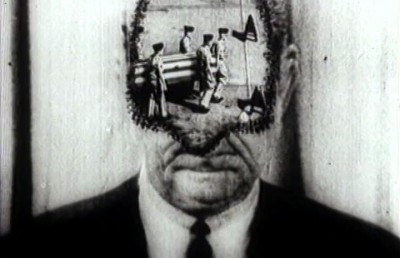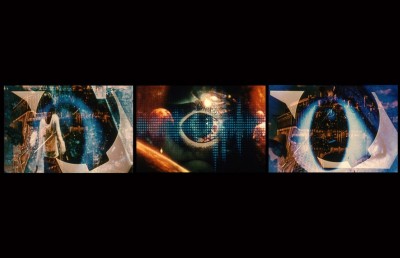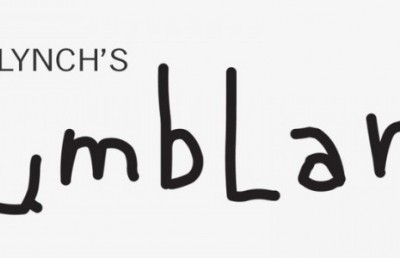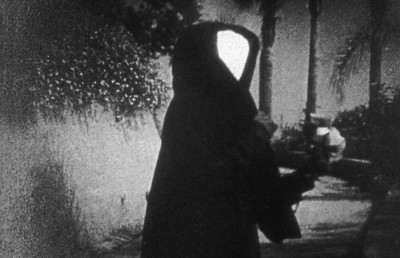Small Gauge Trauma
Global Shorts

Bless the folks at Fantasia and Synapse Films for putting together this wonderful selection of short films that have played at the Fantasia Film Festival over the last nine years. Both operating out of Montreal, Fantasia and Offscreen share a lifeline, with Fantasia having its debut only one year before Offscreen, in 1996, hence we have seen Fantasia grow from a cult festival to the largest and arguably most important genre festival in North America. Offscreen is pleased to see them spreading out to DVD production (with Synapse Films), especially with a DVD featuring an often overlooked or under appreciated format, the short film. One thing is certain, the short film has never been marginalized at Fantasia, and this collection is a testament to the festival’s ongoing appreciation and support of the short film. When it comes to the short film, power comes in many forms, and they are all present on this collection, from the intense and visceral (For the Love of Mother Only, I’ll See You in my Dreams, Tea Break) to the quiet and understated (I’Ilya, Grandfathers).
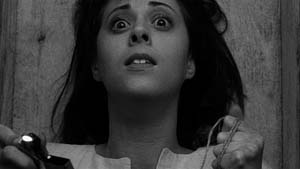
If selecting the ‘play all’ option, the collection starts with Sister Lulu (UK/Welsh, Philip John, 2001, 5 mins., 35mm). Stunningly shot in glorious black and white, this little beauty is over before you realize it, thanks to a great performance as the wistful, trusting nun Novice, from Welsh actress Siwan Morris. The film opens with a tight close-up of a young woman (Novice) holding a lit lighter in one hand and a cord ready to be tugged in the other. After yelling out for a certain Sister Lulu (to be played by Joanne McQuinn), she begins to talk to the camera, recounting her tale of life at a monastery, which triggers a flashback. The flashback begins with an overhead shot of Novice being dumped into a vat of cleansing holy water. Before long Novice pines for the uncloistered walls of the real world. However, she learns that the quick way out of the convent is through the amorous desires of Sister Lulu, which she has no qualms in satisfying. Sister Lulu’s exit plan includes a special sleeping potion that will make Novice appear dead. Once presumed dead she will be taken outside the grounds and buried, and then Sister Lulu will dig her out from her grave and free her. At this point we surmise (if we haven’t already) that Novice is in a coffin six feet underground. As signs of uncertainty and fear begin to appear, Novice’s flashbacks turn to violent fantasies (these are filmed in a murkier, gloomier black and white). We cut back to Novice in her coffin, who is now resorting to panic induced yells: “So where the fuck is that dyke old bitch….open this lid you fucking bitch.” The camera pans and tilts up along her signal cord, a hidden cut continues the movement above ground, revealing a sinister looking Sister Lulu kneeling at her grave, stopping the signal bell and removing it from the attached cord. As she rises to leave, the camera tracks back diagonally to reveal a row of similar graves where other innocent nuns have fallen before Novice. This twist ending reveals a lesbian, serial killer nun film. Now that must be a first! Welsh director John gets the final word when he calls his film a “European flavored, black and white, porn, existential horror short!”
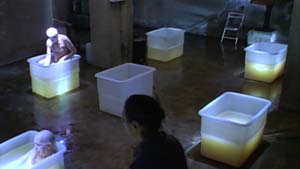
One of the quiet, understated, get under your skin shorts, is Abuelitos (Grandfathers), directed by Paco Plaza (Spain, 1998, 15 mins. 35mm). Perhaps no National cinema is so deeply influenced by its cultural back ground of Catholicism as Spain. This is often reflected in the material and sensibility of the horror and the fantastic, where common religious rituals are pushed that little bit further into areas of the uncanny and the surreal. With ritual at every stage of life in Catholicism, and none more so that birth and death, it is not surprising that these subjects are often treated with ‘religious’ fervor in Spanish horror cinema. In this harrowing film an old age home becomes a purgatory for (mainly) men waiting for death. The soft, luminous church-like lighting in key scenes adds to the sense of ritual and sacrifice, where, with food at a premium, the extra sickly are killed to benefit the living. And young children are brought in as a celebratory meal. In one of the film’s highlight scenes, a row of old men are bathed in plastic tubs illuminated from within by a spiritual-like halo. Intermittent choral music adds to the ritualistic atmosphere. In some respects this does for old age homes what Nacho Cerda’s Aftermath did for the autopsy room: render it a sense of dread and inquietude.
Strangely, the film on this collection which comes closest in tone to Abuelitos is the stunning animated short The Separation by Robert Morgan ((UK, 2003, 10 mins.), hence I am not surprised that in the ‘play all’ option it follows Abuelitos. Although only a two-character piece, the soft lighting, minimal dialogue (hardly any in The Separation), importance of set design, and sense of portentous doom gives them a similar tone. Synapse Films’ uniformly excellent transfers across this DVD really bears fruit on The Separation because of its highly detailed set design, vibrant color schemes and impressive make-up work. It is unusual for an animation, puppet animation (made in silicone) in this case, to effect an audience on a strong emotional level, but Morgan succeeds in generating real audience sympathy for the set of Siamese twins who are unable to deal psychologically with their physical separation (not at birth, but later as babies). We first see the twins floating united in a womb, then as babies in the opening hospital scene, where they are soon to be separated. There is a striking shot which effectively symbolizes their symbiotic unity and at the same time their separation. The twins are seated on a bed, with one of them holding a doll and the other a red rose. When one puts the rose to their nose, we can see that both of them are experiencing the scent of the rose. In the next longer shot of them we see a second single rose alone in the far background of the room in a vase, moments before the doctors enter to perform the separation.
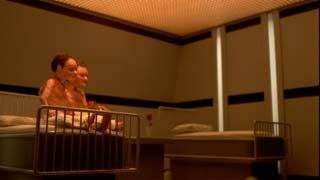
This rose, then, ‘separated’ from the other rose the twin is holding, reflects their imminent separation (and based on Morgan’s commentary track the film does not shy away from similar foreshadowing devices). The film flash forwards to them as adults, working together in an industrial factory producing rubber dolls. The doll factory is where the detailed set design really gains from the pristine transfer (it helps that the film was made in 35mm). One of them gets the idea –after stitching together two dolls– that they can stitch each other together and be reunited. They collaborate on building a huge monstrous sewing machine-like apparatus, but when something goes wrong one of the twins gets trapped under the rampant threading machine and nearly killed. We flash-forward to their old age, and find the other twin –or what is left of him– entirely bandaged. The twin removes the bandages to reveal the extent of his brother’s mutilation (he looks like Venus de Milo). The film ends with the elderly twins returning to the same hospital bed as in the opening. With the limbless brother wrapped under his brother’s tuxedo, the dying twins lie down on the bed and re-enact the opening scene with the doll, which triggers a fantasized vision of their rebirth as adult babies reunited –as they were in the opening womb shot. Although the film often cited as an influence on The Separation is (rightly) David Cronenberg’s Dead Ringers, the final shot also recalls the finale of 2001: A Space Odyssey. The film is accompanied by a commentary track with Morgan and producer Sylvie Bringas. It is refreshing to hear a filmmaker who is not afraid to discuss more than just technique or production notes, but analysis and meaning.
The other film I pointed out for its understated power is L’Ilya (Japan, Tomoya Sato, 16mm, 39 mins.), the longest film in the collection and the one which the brings the DVD to a conclusion, perhaps fitting given that it is a film about suicide. It is also a film about a lot of other things relevant to contemporary Japanese society, like finding the strength to live on when things are on coast, searching for meaning beyond what may be expected of you, learning to communicate and express your feelings, but most of all, it is about suicide. No doubt that suicide has a strong hold on the collective psyche in a nation where suicide –the art of seppuku– was once seen as a justified means of restoring dignity or self-worth. But in a post-Imperial Japan suicide no longer has that element of social acceptance, and I’Ilya tells the story of a 23 year-old woman who makes a living video recording people committing suicide (with their full consent). The film begins with two such ‘clients’ and establishes a mock-documentary, film-with-a-film structure which is mostly abandoned later. L’Ilya treats this macabre enterprise as a job, even meeting with a promoter for business dinners. Although the mechanics of the process appear professional, she claims to be a ‘video artist,’ editing the footage, adding music and playing the footage at night, which raises the age-old question: does the end justify the means? To what end is art worth sacrificing for? Her methodology is to not get involved in the process –as she says to one of her subjects– she does nothing to help, stop or facilitate the suicide. Her function is merely to record. But how can anyone not be touched or moved by these tragic, sad encounters?
Although the subject on its own portents broader social issues, a textual analysis of the film reveals a singular, local meaning: that L’Ilya’s exposure to all these suicides, to which she initially has little emotional response, in the end moves her to self-awareness. This transition to self-awareness begins with her live-in photographer boyfriend, who has an overt distaste for L’Ilya’s promoter and the whole idea of marketing death. As he says, “suicide is a trend now.” L’Ilya’s relationship with her boyfriend seems, like her work, guarded and polite. The boyfriend asks L’Ilya if she has any new clients on the horizon, and then follows this by jokingly asking her, “Shall I kill myself?” L’Ilya just shrugs it off with a laugh, never for a moment thinking it may be a cry for help or attention. Her own emotional state and relationship with her boyfriend is mirrored in an attractive 29 year-old woman who engages her services. L’Ilya’s conversation with this woman becomes more personal than with the others, and L’Ilya seems surprised that a seemingly intelligent, beautiful woman would commit suicide based on her break-up with a man she did not know very well. The key here is the perceived lack of communication between the woman and her former lover, with the implication that perhaps if they had talked more she would not be in this position, a situation which mirrors what will happen between L’Ilya and her boyfriend. This link between their emotional and relational situation is cemented when L’Ilya’s boyfriend commits suicide while she is viewing the suicide footage of the 29-year old woman (his suicide is quietly handled by synecdochic cuts to shots of bed sheets with increasingly larger blood stains). With her emotional relationship to suicide becoming more personal (first through her alter-ego in the shape of the woman, then her boyfriend), she loses her grip on reality and begins to see incarnations of her boyfriend and the 29 year-old woman. She even imagines the woman turning the camera on her, asking her the same question she did: “What’s your reason for suicide?”
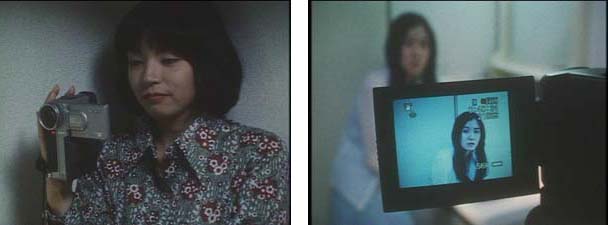
As her emotional proximity to suicide becomes increasingly more personal, the next logical step is to commit suicide herself, which she does in the exact same manner as the 29-year old woman –by slitting her wrists in the bathroom and submerging her arm in a water-filled sink. This scene then cuts to the morgue, where we see L’Ilya asked to identify her boyfriends’ body. But is this morgue scene real? Did she survive the suicide attempt, or is this her fantasy? You have to stick it out right to the end credits to find out whether L’Ilya actually died. The end credits are interspersed with photos of each of her suicide cases, with name, age, method of suicide, place of suicide, etc. She is the last in the sequence, and next to suicide method we see: wrist cutting (attempted).
Where the film gains its power is in the tension between this highly emotional content and the underwhelming manner in which it is filmed. Outside of the opening documentary-like footage, much of the film is shot like a soap opera, with high contrast, flat lighting, minimal camera movement, normal angles, conventional scene breakdowns, and uninvolving music. The style changes somewhat toward the end, but director Sato minimizes the easier pay off of cinematically achieved emotions in favor of giving depth to the theme of suicide and the lead character’s slowly mounting awareness of her own role in the process. (L’Ilya is also available along with two other middle length films by Tomoya Sato, A Deadly Silence (2004) and Marehito (1995), on the DVD label Crippled Brothers.)
Fantasia would not be the same without some graphic shock and visceral horror, so there is plenty of that on display in this collection. Two of the most impressive from the ‘more-is-not-necessarily-bad’ school are Amor Só de Mãe (Love From Mother Only) by Dennilson Ramalho (Brazil, 2003, 21 mins. 35mm) and I’ll See You In My Dreams by Miguel Ángel Vivas (Portugal, 2004, 20 mins. 35mm). Jose Mojica Marins, who gives a brief introduction to the DVD, would be proud of his compatriot Ramalho’s Love From Mother Only, an incantation of a film which pits Brazil’s religious worlds of Catholicism against (the Afro-Brazilian) Macumba (known since the 20th century in parts of Brazil as black witchcraft). Shot on 35mm widescreen, Love From Mother Only is an assured visual and aural trip into the horrors of religious guilt and power. After passionate sex in the woods (the eroticism undercut by cuts to nearby hanging Macumba skulls) a man, Filho, living with his old mother, is given an ultimatum by his lover, Formosa: leave your mother or you lose me. Later that night Filho goes to Formosa’s hut brandishing a knife he plans to turn on himself with the hope of winning back Formosa, but instead walks into the most perverse scene in the film: Filho enters the candle-filled, red-orange lit room to find Formosa having savage sex with a large man, while a second man seated on a chair behind them masturbates (with full frontal). After the two men leave Formosa becomes possessed, her eyes turning jet black and her voice an inhuman register. She physically overwhelms him and ups the ultimatum: kill your mother and bring me her heart.
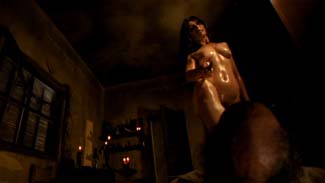
This leads to the centerpiece of the film: an extended crosscutting sequence between Formosa performing a Macumba voodoo-style ritual and Filho at home with his mother (whose house is adorned with Catholic iconography). The scene begins with Formosa slitting her tongue and letting the blood drip down onto her oily, sweaty nude chest, and then alternates between Formosa’s black arts ritual and Filho being cast under a spell which uses his possessed body to murder her mother. The murder of the mother is particularly graphic and brutal (he uses a lead pipe to bludgeon her and tear into her chest to extract her heart). The film is full of convincing graphic special effects, like the above tongue effect, but none of these more elaborate effects are any more fright inducing than the simple ones– like the woman’s jet black eyes when she is possessed by the devil, her well-oiled body when in the throes of Macumba ecstasy, or the guttural voices when possessed.
I’ll See You In My Dreams is an entertaining zombie film which does not reinvent the wheel –director Vivas bears his stripes, with touches lifted from Evil Dead, Demons, The Beyond, and the Romero trilogy– but adds enough twists and innovations to make it a worthwhile addition to the zombie lore. As short films are conditioned to do, the film just opens with the zombies already present, and in the clear majority, without the need to explain how they came to be. It opens/ends with the hero, Lucio, walking through a tree-lined street, bemoaning in voice-over about the natural splendor… “trees, trees, trees, they are everywhere…but the real thing I hate…” as a figure becomes visible at the end of the road… “is zombies….” He then proceeds to shoot the zombie dead. Wearing a long black leather coat, boots, and carrying a shot gun rifle in one hand, Lucio is part spaghetti western/part action film hero. The film also borrows other western genre elements: western styled showdowns and the principal location –a saloon– which is the only bastion of safety against the zombies. Lucio establishes himself as the hero in an early saloon scene where he defends the waitress against the aggressive, unwanted attention of a burly customer. Lucio’s abuse of violence –he continually kicks the man when he is down– reveals a decidedly ‘non-heroic’ sadistic side.
In 20 minutes of screen time I’ll See You In My Dreams packs in a lot of plot and idea, including a formally set-off flashback (image is grainier, more color saturated), some domestic drama of tragic proportions, animalistic sex, and lots of zombie attacks. We even get some character development in the flashback, which reveals another layer of sadism in the hero. He returns home to find his wife with another man (not in an uncompromising situation) and shoots him first before asking any questions. Through a flashback we also learn that the zombie we see locked in a cage in Lucio’s home is his wife. Most zombie fans will be glad to know that the look of the zombies is old school –which is meant as a complement– but their strength and physical dexterity varies. For example, while most of them seem slow moving and not particularly strong, the zombie wife has the strength to overcome Lucio and snap his rifle in two over her legs.
All of this may sound conventional, which to some extent it is, but every shot is handled with great visual panache, with shifts in color lighting, atmospheric backlighting, and dynamic framing (good use of background/foreground for suspense and shock), and scenes are beautifully edited. An example of an absolutely stunning edit comes in the above mentioned saloon scene where Lucio beats up a customer harassing the waitress. Successive cuts to the waitresses face as Lucio defeats the bully give clear evidence of her growing interest in Lucio. With the attacker beaten and crawling on the floor Lucio kicks him in the face. The camera is at ground level. On the right to left movement of his swinging foot the shot cuts to an overhead shot of the woman being thrown aggressively against his bed, with the movement of her body matching the movement of his foot. Not only is it a wonderfully dynamic edit, but its bluntness reflects Lucio’s personality. The noted moment of domestic drama comes after the lovemaking between Lucio and the waitress. Their lovemaking is in plain view of Lucio’s zombie wife, and the carnal scene stirs up the wife’s jealousy. Her escape from the cage is revealed in that time honored horror cliché of the body appearing in a background mirror reflection, but it works as if it were the first time. The subtle difference here is that a candle being lit by the waitress in front of the mirror provides the light which illuminates the zombie standing behind her.

The extent of Lucio’s sadism is clinched through an unexpected act he performs at a crisis point during a zombie attack. The attack occurs in a barn and Lucio and his female companion fight valiantly against a score of zombies. However, they are soon surrounded and placed into a dead end situation by an insurmountable number of zombies. The woman turns to Lucio and asks, “What should we do?” Lucio thinks for a few seconds, then takes her by the arm and tosses her into the crowd of zombies, which buys him enough time to escape! The film ends as it began, on the tree-lined dirt road, with the same lines being repeated, only with the proverbial twist that reveals Lucio has become a zombie.
Two attractive female neighbors. A peeping tom. A killer with black leather gloves and a razor. Possible lesbian lovers. A Female killer. A music box. Fetishistic movements over precious objects. A single revelatory clue. All of this can only mean one thing: the Belgium team of Hélène Cattet and Bruno Forzani. Their wonderfully rendered homage to the giallo, Chambre Jaune (Yellow Room, 2002), is one of the most beguiling and stylish films on this collection. Chambre Jaune, a giallo homage with a hint of Chris Marker’s La Jetée tossed in (the use of still frames, the hushed voice-over, the tortured memories), is one of the most cinematic looking digital films you will ever see, with an innovative use of colored gels and a saturated color scheme which works as both an homage Argento and Bava, but also as a suggestion of the lead character’s fractured emotional and mental state (we learn retroactively that the film is told in flashback, from the point of view of the killer, who is seated in the titular room –which is not always yellow but sometimes green, blue and red– and the symbolic site of tortured memories). Kudos to Cattet and Forzani for accommodating their North American viewers by giving their commentary (which is filled with technical info and specific gialli influences) in English (which was no doubt not easy for them).
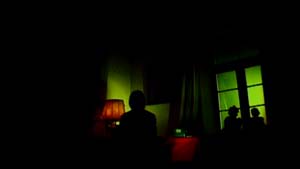
Japanese Manga animation has always been popular at the Fantasia Film Festival. However, since there are not any on this collection, Manga fans (and I don’t count myself as one) will have to content themselves with the Manga-influenced Argentinean Gorgon (Salvador Sanz, 2004, 15 mins., digital), an adaptation of the Greek myth of Medusa, which recounts the tale of a woman (or triplet of women in variants of the myth) with a head of living snakes whose gaze can turn people into stone. The same weaknesses and strengths common to most Manga films can be found here: a ludicrous plot generating a powerful aesthetic vision. In this case the three gorgon sisters form a mega-pop star girl-band named Elektra. After taking the music world by storm the band attempts to forge a mystique by leaving the music industry and clouding themselves in mystery. When fan anticipation reaches its peak the band returns with a wholly changed image (from pop to Goth). The ‘marketing’ scheme ends up being a ploy to increase world attendance for their final reunion concert, where they reveal their gorgon gaze and turn millions of people to stone, setting off the apocalypse. (This produces one of the script’s best lines, “the new stone age.” Luckily the subtitles for this film, which are rife with spelling and grammatical errors, don’t mess up this line!). Going by previous Mangas, some credit must be given to director Sanz for the possibility of reading this plot as a social allegory on the power of popular culture –or at least a satire on the contemporary music industry. Allegory or not, Sanz’s mix of realistic drawing, expressionistic visuals (noirish lighting), and dynamic comic book framing (coupled with mobile framing) paints a convincing apocalyptic landscape of dread and paranoia.
The expansive range within animation in terms of style and content is evident going from the slick, digital Gorgon to Flat n’ Fluffy (Canada, 2001 7 mins., 16mm), Ben Boucher’s seven minutes of riotous violence for the sake of non-violence. Using simple cell animation Boucher takes us into the twisted mind of a peace loving pothead who shoots acid and ventures into India-inspired nirvana whenever things get difficult, and his gun happy Russian neighbor. When shooting practise leads to the death of their elderly British neighbor’s dog Fluffy, their attempted cover-up –driving over the dog repeatedly with their van right in front of the British couple’s front window– doesn’t work. The elderly couple, led by an ex-General who is still fighting the battle for Falkland Islands –with miniature toy vehicles– take their revenge on their dog’s assassins by blasting their van to smithereens, which leads to a montage of flying sheet metal which splatters an array of nearby animals (including a Garfield look-a-like). Lots of dead animals (though we are assured in the credits that no animal was hurt during the making of the film), some trippy visuals (with a nod to Cheech and Chong) and a curtain raising folk-pop song make this an entertaining throwback to 1970’s animation. The film contains one of the most unusual (and racy) commentary tracks you’ll ever hear, rendered as if it were being told by a ‘computer’ (K-lite 69-69), in an appropriate mechanized voice. The transposition of sexual terminology into machine rhetoric does wear thin after a while, but it must be applauded for its brazen originality. And at times it is funnier than the film!
A common aspect to many short films is the use of mixed formats. One of the shorts in this collection which does this to thematic effect is Infini (Infinity Canada, 9 mins. Digital/super 8/16mm), directed by Guillaume Fortin. Infinity relies on the noticeable differences in medium texture to help locate the viewer in its experimental narrative of a drug-addict’s life recounted through fragmented memory bites. Fortin replaces the cliché of a person’s life flashing before their eyes at the moment of death with a cine-reflexive conceit: what if one’s life was one long film which could be controlled, manipulated and re-edited? The film intercuts between a man in a dingy room, the ‘editor,’ splicing together pieces of film, scenes of the young overdosed woman fighting for her life in a hospital emergency room, home movie footage of the young woman, and a final scene of the woman in the recovery room. Fortin uses grainy super 8mm for the home movie footage (actual home movies from family and friends), crisp, solarized digital video for the hospital scenes, and 16mm for the scenes in the editing room (and, I think, the final scene in the recovery room).
Fortin also establishes clever links between the editing process and the woman’s life that are both formal (graphic) and thematic. An example is the cut from the editor making a physical splice to a quick insert of a forearm bearing a razor cut scar (situating the whole film within the idea of death, suicide and life memories). Fortin makes links between two forms of ‘operations’: in the hospital emergency room as the doctors try to revive the young woman, and the man cutting the super 8mm footage in his cell. For example, a shot of the editor pushing a strip of film into a drain pipe is intercut with fluid flowing through a tube attached to the patient. The Lynchian industrial hums and electronic buzzes which emanate from the flashing florescent bulbs in the editor’s cell can also be seen signifiers of the ebb and flow of life, or a visual correlative to the life support machines we see in the hospital theatre. This paralleling between the practise of editing and of hospital procedure continues during the film. As the woman edges near death the editor’s footage takes on its own life, moving serpent like around his body, tying him to his chair and wrapping itself around his face. In the film’s final shoot we see the woman lying still in a hospital bed. Is she in a coma; is she brain dead? (the latter seems likely given the fear for the condition of her brain expressed by a doctor (or nurse) during the life support procedure).
Knowing that director Fortin studied cinema at both Concordia University and University of Quebec, my guess is that he saw and was influenced by Dziga Vertov’s Man With a Movie Camera; essentially the idea of the editor being able to manipulate and control ‘reality’ as if it were a strip of film; the idea of film as a ‘living’ entity. For example, there is a scene where the editor holds a strip of super 8 film up to the light –we can make out the image of a child. He then slides the strip of film back and forth through his hands, at which point we cut to super 8 footage of a girl running in reverse, and riding her bike backwards, and then cuts to a freeze frame of the girl. These edits are identical to those made by the film-within-a-film editor in Man With a Movie Camera (who is actually played by Vertov’s wife and editor of the film, Elizaveta Svilova). The general idea is similar too. In the Russian film the interaction between edited film and its real life counterpart is meant to suggest the more general idea of cinema as an integral part of the new post-revolution society; whereas here it is based on the idea of an ‘editor’ being able to control a singular life history.
Some serendipity is revealed in the commentary track, where we learn that part of the film –the scenes of the man in the editing room– was shot in the basement of the Imperial Theatre, one of Montreal’s few remaining original big screen theatres (it opened in 1915). Subconscious Cruelty (directed by Karim Hussain, 1999), a film produced by the main force behind this DVD, Mitch Davis, was also partly filmed in the same Imperial Theatre basement. And the Imperial Theatre was home to the Fantasia Film Festival for its first several years, before moving to its present location at Concordia University.
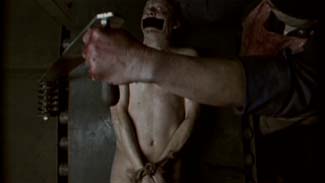
Social message films don’t get any bloodier, gorier and more graphic than Tea Break (UK, 2004, 7 mins., 35mm, Sam Walker). Set in what looks ostensibly like a slaughter house, an employee, cigarette in mouth, goes about his repetitive, mundane job of decapitating nude, gagged and hog tied humans as they slide toward him along a conveyer belt. Once they near him he stops the conveyer belt, holds the head in place with one hand to better expose the neck, thrusts the steel guillotine blade down, tosses the head into a nearby bucket, restarts the conveyer belt…and the cycle continues. Chop after chop, with blood spurting into his chest and face, even the gore itself becomes mundane! The repetitive nature of the job is underscored by the minimalist music. As he nears his tea break, 11 am, the employee’s attention begins to wane with periodic glances at the wall clock. At the strike of 11, with the next victim lined up and waiting for the chop, he goes over to his table for a read and snack (director Walker does not miss a chance at irony by cutting to a close-up of his luncheon meat sandwich.) His break is compromised by moans from the work bench, as the blade is beginning to cut into the victim’s neck. He returns to his work station and lifts the blade from the man’s neck; we hear a mumbled ‘thank you,’ before the worker thrusts down the blade. All of this is, I imagine, a statement against the consumption of meat, and/or the way livestock is reared and killed; a ‘pro-vegetarian’ film if you will. It is a fitting inclusion to the collection, expressing many of the qualities and elements which have come to identify the Fantasia Film Festival: audacity, irony, gore, allegory, dark humor, smarts…and shock.
All in all this is a stand-out collection of short films, with each film adding a unique, cohesive contribution to the overall tone –with the only exception being Ruta Destroy (Diego Abad, Spain, 2002, digital/35mm, 15 mins.), essentially a string of music videos recounting the lifestyle of the “Bakalao” (Spanish term meaning a young rave/party pothead). You can tell that this collection was put together by someone who actually programs for a festival because, unlike some short film compilations, there is consideration given to the sequencing of the shorts for pacing, tone and style. It is always important to begin and end strong and Davis gets it right with Sister Lulu –a film which rung in my head like rock in a rolling barrel– and the quietly powerful L’Ilya. On top of the extras related to the individual films –commentary tracks, deleted scenes, featurettes– the DVD extras include introductions by Jose Mojica Marins and Fantasia Festival program director Mitch Davis and material on the Fantasia Film Festival. Anyone unfamiliar with Fantasia will learn all about the Fantasia phenomenon through these DVD extras, including television promos and trailers featuring interviews with Festival Programmers, Directors, fans, and guests. Given its primary identification as an Asian festival –although that has ostensibly changed since its first few years toward a more international spectrum– the only surprise is that only two of the thirteen shorts are Asian (both Japanese). These and other issues related to the ins and outs of compiling a short film DVD collection will be featured in an upcoming interview with Mitch Davis. For now I’ve been told that a second volume is slated for release by the end of this year and the following titles are confirmed: La Guerra (Spain), The Cat With Hands (UK), Redrat (Uruguay) and Lens (Holland).
Screening Order in “Play All” Mode
1) Sister Lulu. Dir. Philip John (UK, 2001, 5 mins/35mm)
2) Miss Greeny. Dir. Tenkwaku Naniwa (Japan, 1997, 30 seconds/Video)
3) Tea Break. Dir. Sam Walker (UK, 2004, 7 mins/35mm)
4) Amor Só de Mãe (Love From Mother Only). Dir. Dennilson Ramalho (Brazil, 2003, 21 mins/35mm)
5) Chambre Jaune (Yellow Room). Dir. Hélène Cattet and Bruno Forzani (Belgium, 2002, 8 mins/still photography/digital)
6) Flat-N-Fluffy. Dir. Ben Boucher (Canada, 2001 7 mins/16mm)
7) I’ll See You In My Dreams. Dir. Miguel Ángel Vivas (Portugal, 2004, 20 mins/ 35mm)
8) Abuelitos (Grandfathers). Dir. Paco Plaza (Spain, 1998, 15 mins/35mm).
9) The Separation Dir. Rober Morgan (UK, 2003, 10 mins/35mm)
10) Ruta Destroy. Diego Abad (Spain, 2002, 15 mins/digital/35mm)
11) Gorgonas (Gorgons). Dir. Salvador Sanz (Argentina, 2004, 15 mins/digital)
12) Infini (Infinity). Dir. Guillaume Fortin (Canada, 9 mins/digital/super 8/16mm)
13) L’Ilya. Dir. Tomoya Sato (Japan, 39 mins/16mm)



